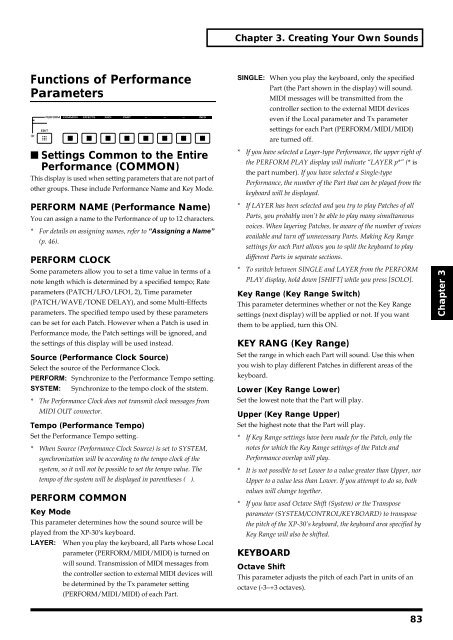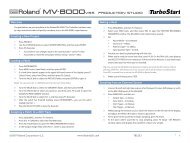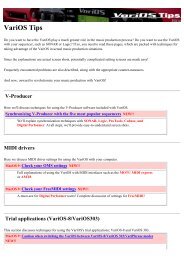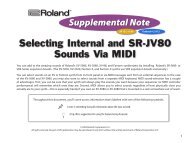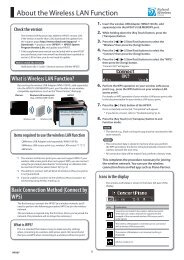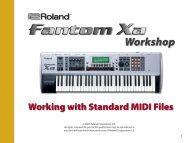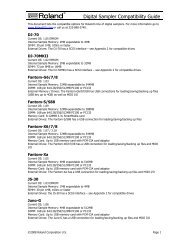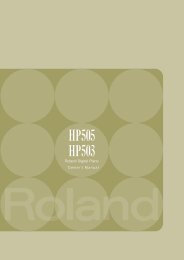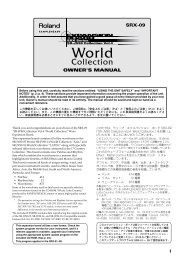You also want an ePaper? Increase the reach of your titles
YUMPU automatically turns print PDFs into web optimized ePapers that Google loves.
Chapter 3. Creating Your Own Sounds<br />
Functions of Performance<br />
Parameters<br />
fig.3-11<br />
■ Settings Common to the Entire<br />
Performance (COMMON)<br />
This display is used when setting parameters that are not part of<br />
other groups. These include Performance Name and Key Mode.<br />
SINGLE: When you play the keyboard, only the specified<br />
Part (the Part shown in the display) will sound.<br />
MIDI messages will be transmitted from the<br />
controller section to the external MIDI devices<br />
even if the Local parameter and Tx parameter<br />
settings for each Part (PERFORM/MIDI/MIDI)<br />
are turned off.<br />
* If you have selected a Layer-type Performance, the upper right of<br />
the PERFORM PLAY display will indicate “LAYER p*” (* is<br />
the part number). If you have selected a Single-type<br />
Performance, the number of the Part that can be played from the<br />
keyboard will be displayed.<br />
PERFORM NAME (Performance Name)<br />
You can assign a name to the Performance of up to 12 characters.<br />
* For details on assigning names, refer to “Assigning a Name”<br />
(p. 46).<br />
PERFORM CLOCK<br />
Some parameters allow you to set a time value in terms of a<br />
note length which is determined by a specified tempo; Rate<br />
parameters (PATCH/LFO/LFO1, 2), Time parameter<br />
(PATCH/WAVE/TONE DELAY), and some Multi-Effects<br />
parameters. The specified tempo used by these parameters<br />
can be set for each Patch. However when a Patch is used in<br />
Performance mode, the Patch settings will be ignored, and<br />
the settings of this display will be used instead.<br />
Source (Performance Clock Source)<br />
Select the source of the Performance Clock.<br />
PERFORM: Synchronize to the Performance Tempo setting.<br />
SYSTEM: Synchronize to the tempo clock of the ststem.<br />
* The Performance Clock does not transmit clock messages from<br />
MIDI OUT connector.<br />
Tempo (Performance Tempo)<br />
Set the Performance Tempo setting.<br />
* When Source (Performance Clock Source) is set to SYSTEM,<br />
synchronization will be according to the tempo clock of the<br />
system, so it will not be possible to set the tempo value. The<br />
tempo of the system will be displayed in parentheses ( ).<br />
PERFORM COMMON<br />
Key Mode<br />
This parameter determines how the sound source will be<br />
played from the XP-30’s keyboard.<br />
LAYER: When you play the keyboard, all Parts whose Local<br />
parameter (PERFORM/MIDI/MIDI) is turned on<br />
will sound. Transmission of MIDI messages from<br />
the controller section to external MIDI devices will<br />
be determined by the Tx parameter setting<br />
(PERFORM/MIDI/MIDI) of each Part.<br />
* If LAYER has been selected and you try to play Patches of all<br />
Parts, you probably won’t be able to play many simultaneous<br />
voices. When layering Patches, be aware of the number of voices<br />
available and turn off unnecessary Parts. Making Key Range<br />
settings for each Part allows you to split the keyboard to play<br />
different Parts in separate sections.<br />
* To switch between SINGLE and LAYER from the PERFORM<br />
PLAY display, hold down [SHIFT] while you press [SOLO].<br />
Key Range (Key Range Switch)<br />
This parameter determines whether or not the Key Range<br />
settings (next display) will be applied or not. If you want<br />
them to be applied, turn this ON.<br />
KEY RANG (Key Range)<br />
Set the range in which each Part will sound. Use this when<br />
you wish to play different Patches in different areas of the<br />
keyboard.<br />
Lower (Key Range Lower)<br />
Set the lowest note that the Part will play.<br />
Upper (Key Range Upper)<br />
Set the highest note that the Part will play.<br />
* If Key Range settings have been made for the Patch, only the<br />
notes for which the Key Range settings of the Patch and<br />
Performance overlap will play.<br />
* It is not possible to set Lower to a value greater than Upper, nor<br />
Upper to a value less than Lower. If you attempt to do so, both<br />
values will change together.<br />
* If you have used Octave Shift (System) or the Transpose<br />
parameter (SYSTEM/CONTROL/KEYBOARD) to transpose<br />
the pitch of the XP-30’s keyboard, the keyboard area specified by<br />
Key Range will also be shifted.<br />
KEYBOARD<br />
Octave Shift<br />
This parameter adjusts the pitch of each Part in units of an<br />
octave (-3–+3 octaves).<br />
Chapter 3<br />
83


